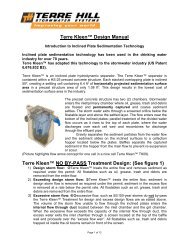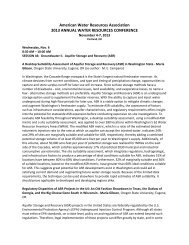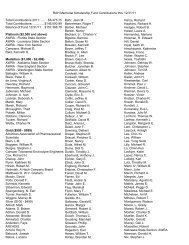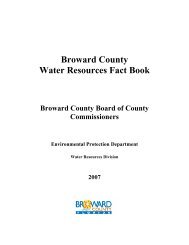N ovember 2 0 0 0 ⢠V olume 2 ⢠N umber 6 - American Water ...
N ovember 2 0 0 0 ⢠V olume 2 ⢠N umber 6 - American Water ...
N ovember 2 0 0 0 ⢠V olume 2 ⢠N umber 6 - American Water ...
Create successful ePaper yourself
Turn your PDF publications into a flip-book with our unique Google optimized e-Paper software.
ARMY CORPS OF ENGINEERS<br />
Gretchen Randall<br />
It hasn’t been a good year for the Army Corps of Engineers.<br />
First, a study of how to improve the Mississippi<br />
River locks and dams system, while still preserving the<br />
ecology of the river, was hit with charges of tampering by<br />
top Army officials. Several other projects have been labeled<br />
as pork by the Taxpayers for Common Sense.<br />
Finally, an attempt by the Clinton/Gore administration<br />
to move control of the Corps to the Executive Branch<br />
failed.<br />
Back in 1993 a $54 million study was begun to study<br />
the navigation needs of the Upper Mississippi and Illinois<br />
waterways. Agriculture interests want larger and more<br />
modern locks on this area of the Mississippi to speed up<br />
barge traffic. Environmental groups claim these changes<br />
would threaten the fish and wildlife populations according<br />
to the Seattle Daily Journal of Commerce (DJC).<br />
Now, early in 2000, according to the Environmentl<br />
News Service, Donald Sweeney, an economist heading up<br />
the team in charge of the study, claimed he was replaced<br />
because he disagreed with the Corps on the cost/benefit<br />
analysis of the project. The Federal Office of Special<br />
Counsel was asked to look into his allegations and found,<br />
"[there is] substantial likelihood that officials in the<br />
Corps have engaged in violations of law, rule or regulation<br />
and a gross waste of funds" after reviewing a 44-page<br />
affidavit filed by Sweeney.<br />
Army Secretary Louis Caldera has since asked the<br />
National Academy of Sciences to conduct a review of the<br />
navigation’s study as well as the Corps’ management<br />
practices. However, the Corps and many of the projects<br />
they oversee have wide support in Congress. Senator Kit<br />
Bond, R-Missouri, said at a hearing of the Senate Subcommittee<br />
on Transportation, "The prosperity of the rural<br />
economy depends on having safe, efficient and reliable<br />
transportation alternatives to help expand export markets.<br />
The aging locks in question are creating bottlenecks<br />
because they are beyond their original design capacity.”<br />
Additionally, DJC reports that supporters of the<br />
study claim that 400,000 industry related jobs are at<br />
stake, while the dams also prevent flooding and provide<br />
recreational facilities for communities. They also claim<br />
that moving the grain by barge lessens air pollution that<br />
would be created if the same amount of grain were moved<br />
by train or truck.<br />
According to DJC, proponents claim a minimum of<br />
seven locks need to be lengthened because as many as 15<br />
barges are linked together and moved as one unit, sometimes<br />
1195 feet long. But [barges] can’t make it through<br />
A BRIEF HISTORY OF THE CORPS OF ENGINEERS (from the Washington Post) . . .<br />
1775 – Gen. George Washington appointed a chief engineer to direct the construction of the fortification at Bunker<br />
Hill in the Revolutionary War.<br />
1802 – President Thomas Jefferson established the Corps to run the engineering school at West Point. The Corps<br />
began to build forts and coastal fortifications.<br />
1824 – Congress established a civilian works program for the Corps beginning with clearing the Ohio and<br />
Mississippi Rivers for navigation.<br />
1865 – After the Civil War, the Corps began work on river navigation, levees, harbor improvements as well as<br />
building the Washington Monument and Library of Congress.<br />
1914 – Corps built the Panama Canal.<br />
1928 – Congress gave Corps control over the Mississippi after a disastrous flood in 1927. They also began<br />
building dams on the Columbia and Missouri Rivers.<br />
1941 – Supervised the Manhattan Project which built the atom bomb. After WWII, Corps built the St. Lawrence<br />
Seaway, Cape Canaveral, and the system of canals which drained the Everglades.<br />
1972 – When Congress passed the Clean <strong>Water</strong> Act it required developers to get permits to drain wetlands from<br />
the Corps.<br />
2000 – Allegations arose that Corps tried to rig the outcome of a study of Mississippi River lock improvements.<br />
Clinton/Gore administration tried to take Executive Branch control of Corps but Congress objected and the<br />
attempt was scrapped.<br />
V<strong>olume</strong> 2 • N<strong>umber</strong> 6 <strong>Water</strong> Resources IMPACT • 5
















